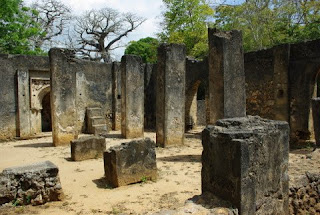After our Mt Elgon trek we were about ready for some easy travel so we headed to the Coast. The first port of call was Mombasa. A busy port town and Kenya's second largest city. It's hot, humid and sultry and was great to feel after too long in the UK.
This was our introduction to the history of the coast. The length of the coast has been fought over for centuries by various people. Arabs from Oman, Portuguese sailors and of course the ever present British are the main players. It was a major link between the Far East and eventually Europe, with activity dating back as far as the 12th century. As with all trading centres, there had been plenty of wealth generated at times and some subsequently squandered. Ruins are scattered along the coast. The wealth was generated by all the nice commodities: ivory, spices and slaves. The area has a different feel and is due the Swahili culture. The old parts of town are mazes of tiny alleys with highly ornate wooden fixtures, including doors, windows and balconies. Islamic religion is more prominent and this is reflected in the clothing (both women and men) and mosques with their regular call to prayer (including 5am). A crazy mix of Africa, Arabic and Eastern cultures.

A mosque at sunset above, and a typical carved door below.

The main attraction in Mombasa is Fort Jesus. A fort built by the Portuguese around th 15th century. A coral rag castle. A lot of the construction in this area is built by carving coral blocks out of the ground, left over from higher ocean levels a million years ago.

Mombasa didn't really satisfy our coastal cravings as it is a bustling city. So after a few days we headed up the coast to Malindi. An Italian resort town where they flock to escape their Winter. Being a whitey we were greeted with 'Ciao' by all the local kids. This was great for a bit of Italian influence in our diet. We had a delicious pizza and numerous gelato excuses in Malindi. However the beach wasn't quite the picture the guide book painted, as the whole ocean was a vibrant shade of red, thanks to the all dust being washed down the rivers from a bit of rain inland. Great. It was also our introduction to the hustle on the beach. For the next 4 weeks we were offered snorkelling trips multiple times on a daily basis. Also jewellery and whatever else they could think of.

We did however find a saviour. Watamu, a smaller town about 30 minute drive down the road. A beautiful white sandy beach, crystal clear water and less hustle. So we spent the next two days doing day trips because we couldn't be bothered changing hotels.

We also did a day trip out of Malindi to the Gede ruins. A city of ruins from the 13th century that was only discovered 50 years ago. The city was quite developed with a large outer wall, a large mosque, numerous water wells, toilets and flowing water. All of this wealth created by the trade on the nearby ocean.


We then caught a long bumpy bus up to Lamu. Lamu is on an island and there are no roads and no cars. Everything arrives by boat. Donkeys are the work-horses of the island. Lamu was great and we ended up spending nearly a week here. So nice and peaceful without any road noise. Wandering around the narrow alleys and exploring the city. Or wandering up to the nearby beach. Time passed effortlessly.

One of our places we stayed in Lamu. Very cool catacomb of concrete.

We spent Christmas in Lamu. Breakfast was a simple affair of coffee, fresh fruit and pastries. We then went out to a big seafood lunch (Lobster and Crab). And had a casual dinner and a few drinks with some friends.

Boxing Day we celebrated in typical style with our own little sailing trip. Dhows (the local boats), have been hand crafted here for centuries. They are completely made by hand, everything down to a hand-sewn sail. They are amazing and sail really well.

We went out, did a bit of fishing and then came back for BBQ lunch on the beach.

After Lamu and clocking up a month in the continent, we were ready for another dose of animal action. So we headed back down to Mombasa and booked in for a 3 day safari through Tsavo West and Amboseli National Parks.

More up close and personal interactions with the animals. Plenty of elephants although the animals weren't as prolific as the Masai Mara. We were expecting to be camping, but ended up in some amazing lodges. One of those mis-communications in our favour. The one below was our first night. We awoke to a herd of buffalo feeding in the morning. This is on top of the elephants drinking throughout the night and a leopard wandering across the one spot light they had set-up.

Tsavo West had some amazing landscapes but a lot of vegetation, which makes the animals harder to spot. But when you do spot them they are close.

Amboseli was big open Savannah plains. With huge herds of elephants and Kilimanjaro looming nearby.

Crystal clear Kilimanjaro (5,800m asl) at 5:30am.

After our safari we went back to Mombasa and hung out on the southern beaches for a few days. These are very touristy. We did manage to get away from the crowds in a sacred forest called Kaya Kinondo. A small patch of forest that is believed to be sacred by a local tribe. It was great to wander around and here the stories and beliefs. Bella is powering up by hugging a tree.

Next is Tanzania.
Photos
